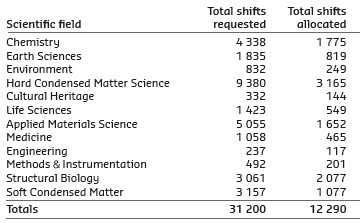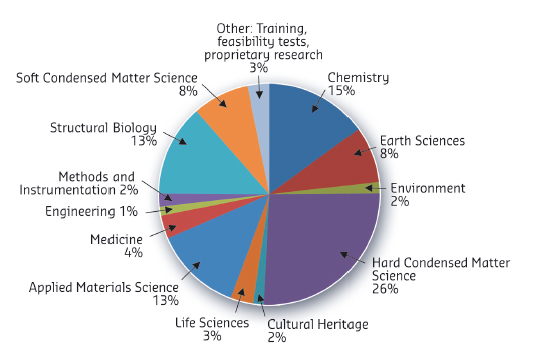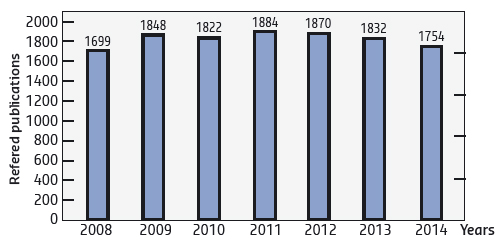User operation
User operation
Following 20 years of successful operation for scientific users (September 1994 to September 2014), we look back on user operation at the facility over the past year 2014. The ESRF has been back in full user operation for the majority of users since 2013, but Phase I of the Upgrade Programme continues and several beamlines were either fully or partially closed during 2014 for upgrade. ID01 (UPBL1) and ID32 (UPBL7) were closed for almost the whole year, taking their first user experiments in December 2014; ID31 has been closed for upgrade for the whole year and the new upgrade beamline ID22 opened in May 2014 (UPBL2); ID02 (UPBL9a) was re-opened more than half way through the year while new beamlines ID16A-NI and ID16B-NA were also only partially open (UPBL4); ID14 closed and one of the new MX beamlines, ID30A-1, opened half way through the year (UPBL10). In total, the equivalent of around 23.3 ESRF publicly funded beamlines (out of an optimum of 29.5 in the portfolio) and 9 CRG beamlines were available for users in 2014. Figure 170 shows the number of applications for beamtime received since 2008. Despite the heavy construction programme and the unavailability of a non-negligible number of beamlines, 2014 saw the highest ever number of proposals submitted to the ESRF in its history. This shows that the user interest in the ESRF has not diminished in any way and is, at the moment, even stronger than in the past.
 |
|
Fig. 170: Numbers of applications for beamtime, experimental sessions and user visits, 2008 to 2014. N.B. Final numbers of experimental sessions and user visits for 2014 were not available at the time of going to press. |
Proposals for experiments are selected and beamtime allocations are made through peer review. As in previous years, beamtime for 2014 was allocated based on recommendations made by review committees of specialists, for the most part from European countries, Israel and South Africa. A new structure has been in place since 2013 for the proposal review process, with beamline-based committees allowing all proposals received for a particular beamline to be assessed by the same review committee. This gives the committees a better overall view of all the projects proposed for a single beamline, and allows them greater flexibility to optimise the selection of proposals awarded beamtime for each beamline. Proposals for experiments in 2014 were reviewed by 10 review committees grouping the following beamlines of similar techniques or activities:
- C01 (ID01, ID03, BM25B, BM32)
- C02 (ID11, ID15A, ID15B, ID22)
- C03 (ID12, ID20, ID26, ID32, BM28)
- C04 (ID24, BM01B, BM08, BM20, BM23, BM25A, BM26A, BM30B)
- C05 (ID06-LVP, ID09A, ID18, ID27, ID28, BM01A)
- C06 (ID17, ID19)
- C07 (ID16A&B, ID21)
- C08 (ID02, ID13, BM26B)
- C09 (ID09B, ID10, BM02)
- C10 (Structural Biology Beamlines).
The scientific areas of the ESRF research activities reviewed by these ten committees are shown in Table 7.
 |
|
Table 7: Number of shifts of beamtime requested and allocated for user experiments, year 2014. |
In September 2014, an 11th review committee C11 was created and the beamlines reviewed by committees C03 and C04 were redistributed so that some of those beamlines are now reviewed by C11. This modification concerns beamtime allocation for 2015 and so will be described in more detail in next year’s report concerning 2015 operation.
The review committees met twice during the year, around six weeks after the deadlines for submission of proposals (1 September 2013 and 1 March 2014). They reviewed 2113 applications for beamtime, and selected 864 (40.9%), which were then scheduled for experiments.
Requests for beamtime in 2014, which is scheduled in shifts of 8 hours, totalled 31 200 shifts or 249 600 hours, of which 12 290 shifts or 98 320 hours (39.4%) were allocated. The distribution of shifts requested and allocated, by scientific area, is shown in Table 7.
 |
|
Fig. 171: Shifts delivered for experiments, March to July 2014, by scientific area. |
The breakdown of shifts delivered for experiments by scientific area in the first half of 2014 is shown in Figure 171. This same period saw 2667 visits by scientists to the ESRF under the user programme, to carry out 643 experiments. Overall, the number of users in each experimental team averaged just over 4 persons as in all previous years, and the average duration of an experimental session was 9 shifts. This can be further broken down to show an average duration of 3 shifts for MX experiments and 14 shifts for non-MX experiments. The annual number of experimental sessions and user visits since 2008 is shown in Figure 170. The effect of the reduction in beamtime available in 2011 and 2012 due to the long shutdown is clearly visible, and even though the figures for 2013 show the return to something close to pre-shutdown user operation, the unavailability of the remaining upgrade beamlines due to the ongoing Phase I programme means that, for the time being, the number of experimental sessions and user visits is still slowly growing back towards its optimum level. This will also be the case for 2014 due to the upgrade beamline work listed at the beginning of this report, but once all beamlines are running towards the end of 2015 the trends suggest that we may return to a higher level of usage than before, despite the permanent closure of two beamlines since 2010.
One of the new upgrade beamlines that came online in 2014 is MX beamline ID30A-1, also known as MASSIF-1, which is the first beamline in Europe to offer fully automatic hands-off screening and data collection for structural biology. Users do not come to the beamline but instead send their samples, which are automatically analysed. This analysis can include the collection of full diffraction datasets, and is carried out based on information supplied by the user via the ISpyB LIMS for structural biology beamlines.
One of the principle measurable output parameters of the ESRF is the number and quality of publications accepted in peer-reviewed journals. The number of publications rose continuously over the past years to reach a plateau of just under 1900 publications per year, corresponding to the maximum operation level of the ESRF before the Upgrade Programme, as shown in Figure 172. Despite the 6 month shutdown between 2011 and 2012 for the construction of the new EX2 experimental hall, the number of publications has not fallen in any significant way. These are excellent figures, with a publication output systematically on a level of well over one publication per experimental session. The year 2014 promises to be highly fruitful, with 1754 publications registered so far in the ILL/ESRF Library database, which is higher than the 2013 figure at this same time last year. Since the ESRF began user operation back in 1994, a total of 25148 publications have been accepted in peer-reviewed journals. Of these, nearly 300 every year are published in high impact factor journals.
 |
|
Fig. 172: Numbers of publications appearing in refereed journals reporting on data collected either partially or totally at the ESRF, 2008 to 2014. |
User responses to questionnaires show once again that the ESRF continues to maintain its excellent reputation concerning the assistance and service given by scientists and support staff on beamlines, and travel and administrative arrangements, in addition to the quality both of the beam and of the experimental stations. Facilities on site, such as preparation laboratories, the Guesthouse and a canteen open 7 days a week, also make an important contribution to the quality of user support.



